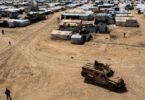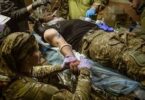BEIRUT/IDLIB (AP): It had been nearly a decade since Mahmoud Al-Khalaf laid eyes on his father, but he immediately recognized the bruised and battered face in the graphic photograph circulating online.
It was one of four published samples from a cache of 800 images allegedly showing Syrians who died in the summer of 2013 in government detention in the northern Aleppo Central Prison.
Reuters could not immediately verify the accuracy of the four photos published by the Syrian website Zaman Al-Wasl. The Syrian government did not respond to a request for comment.
Zaman Al-Wasl said it had received the full portfolio from the Syrian military photographer who took the images in 2014 and later defected, without disclosing the soldier’s name.
A previous batch of photos taken by another Syrian military photographer codenamed Caesar who defected in 2013 set off a diplomatic furor when some of them were published in 2014. Former war crimes prosecutors described those images as clear evidence of systematic torture and mass killings.
A US law that imposed a tough round of sanctions on Syria in 2020 was named the Caesar Act, after the photographer.
Zaman Al-Wasl called the latest cache of photos “Caesar 2,” suggesting the pictures have similar potential to shed light on the behavior of Syrian security forces.
Like the earlier photographs, the new batch of photos showed bodies with blackened skin, some with visible wounds to their torso and others with bruises around their eyes.
Khalaf said only part of his father’s face was recognizable beneath the bruises.
“It was so hard to look at the picture and see what they did to him,” he told Reuters from Turkey, where he and his four siblings fled with their mother in 2014.
He said his father had been arrested in 2011, the year Syria’s conflict broke out, and had not been heard from since.
“We still had a small sliver of hope that he was still alive. We never got official confirmation until now,” Khalaf said.
Zaman Al-Wasl’s editor-in-chief Fathi Buyud told Reuters at least one other family had also been able to identify a loved one in the photo.
Tens of thousands are estimated to have disappeared in Syria’s prisons since 2011, leaving families both in the country and abroad wondering what happened to their relatives.
The UN Secretary General’s office last month recommended establishing “a new international body…to clarify the fate and whereabouts of persons reasonably believed to be missing in the Syrian Arab Republic.”
Without this mechanism, families like Khalaf’s have searched for answers in photo dumps, death certificates published by Syrian authorities years after individuals passed away, or scanning surviving detainees released in official amnesties.
Syrian woman Yasmin Mashaan learned of her brother’s death in government detention when someone tagged her in a photo from the Caesar cache that was circulating on social media platform Facebook in 2015.
“There’s anger, sadness, you just want to scream to the heavens – and at the same time you think, ‘thank God he doesn’t have to be tortured anymore,’” the 42-year-old told Reuters.
Mashaan, who now campaigns for other relatives of forcibly disappeared Syrians with the Caesar Families Association, said the new batch of photos from Aleppo “reopens old wounds.”
A study earlier this year by the association found that the unregulated publishing of such images by media outlets caused families “a lot of pain.”
Laila Kiki, executive director of The Syria Campaign, a group seeking justice for crimes during Syria’s war, said the new photographs should be handed to Syrian rights groups and independent investigators to verify and use in possible international criminal proceedings.
“Family members of those disappeared and detained in Syria should not learn of their deaths in news reports or be forced to search through distressing images of tortured and mutilated corpses online to discover the fate of their loved ones,” Kiki told Reuters.
The Commission on International Justice and Accountability said it had not sought access to the new batch of photos, but said they “appear to verify” other allegations of violations.
“These photos may help shed light on (the) destiny of individual prisoners, many of whom lost their lives in Aleppo prison. They may also be used by national justice actors in any future cases,” said CIJA’s director of external relations Nerma Jelacic.
War crimes investigators at the UN Commission of Inquiry on Syria said the “emergence of this reported cache of photographs” once again showed that an international mechanism to determine the fate of the missing “is urgently needed.”
President Bashar Assad has not commented directly on the original Caesar photographs since a 2015 interview, when he dismissed them as “allegations without evidence.”






